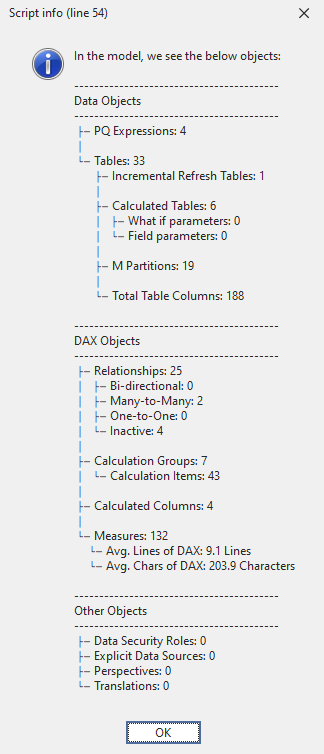Count Things in the Model
Script Purpose
If you want to get an overview of what's in a model and how many objects there are:
- How many measures are in a model.
- How many columns & calculated columns are in a model.
- How many tables & calculated tables are in a model.
- How many relationships, inactive relationships, etc.
Script
Count the number of model objects by Type
// This script counts objects in your model and displays them in a pop-up info box.
// It does not write any changes to this model.
//
// Use this script when you open a new model and need a 'helicopter view' on the contents.
//
// Count calculation groups & calculation items
int _calcgroups = 0;
int _calcitems = 0;
foreach ( var _calcgroup in Model.CalculationGroups )
{
_calcgroups = _calcgroups + 1;
foreach ( var _item in _calcgroup.CalculationItems )
{
_calcitems = _calcitems + 1;
}
}
// Count partitions and DAX parameters
int _partitions = 0;
int _whatifparameters = 0;
int _fieldparameters = 0;
foreach ( var _table in Model.Tables )
{
foreach ( var _partition in _table.Partitions )
{
string _type = Convert.ToString(_partition.SourceType);
string _exp = Convert.ToString(_partition.Expression);
if ( _type == "M" )
{
_partitions = _partitions + 1;
}
else if ( _type == "Calculated" && _exp.Contains("NAMEOF") )
{
_fieldparameters = _fieldparameters + 1;
}
else if ( _type == "Calculated" && _exp.Contains("GENERATESERIES") )
{
_whatifparameters = _whatifparameters + 1;
}
}
}
// Average measure length
decimal _numLines = 0;
decimal _numChars = 0;
int _measures = Model.AllMeasures.Count();
foreach ( var _measure in Model.AllMeasures )
{
_numLines = _numLines + _measure.Expression.Split("\n").Length;
_numChars = _numChars + _measure.Expression.Length;
}
_numLines = Math.Round(_numLines / _measures, 1);
_numChars = Math.Round(_numChars / _measures, 1);
// Return the pop-up
Info ( "In the model, we see the below objects:\n\n"
+ "-----------------------------------------\n"
+ "Data Objects\n"
+ "-----------------------------------------\n"
+ " ├─ PQ Expressions: " + Convert.ToString(Model.Expressions.Count()) + "\n"
+ " │\n"
+ " └─ Tables: " + Convert.ToString(Model.Tables.Count()) + "\n"
+ " ├─ Incremental Refresh Tables: " +
Convert.ToString(Model.Tables.Where(
_ir =>
Convert.ToString(_ir.EnableRefreshPolicy)
==
"True").Count()) + "\n"
+ " │\n"
+ " ├─ Calculated Tables: " +
Convert.ToString(
Model.Tables.Where(
_tables =>
Convert.ToString(_tables.Columns[0].Type)
==
"CalculatedTableColumn").Count()) + "\n"
+ " │ ├─ What if parameters: " +
Convert.ToString(_whatifparameters) + "\n"
+ " │ └─ Field parameters: " +
Convert.ToString(_fieldparameters) + "\n"
+ " │\n"
+ " ├─ M Partitions: " +
Convert.ToString(_partitions) + "\n"
+ " │\n"
+ " └─ Total Table Columns: " +
Convert.ToString(Model.AllColumns.Count()) + "\n\n"
+ "-----------------------------------------\n"
+ "DAX Objects\n"
+ "-----------------------------------------\n"
+ " ├─ Relationships: " +
Convert.ToString(Model.Relationships.Count()) + "\n"
+ " │ ├─ Bi-directional: " +
Convert.ToString(Model.Relationships.Where(
_relationships =>
Convert.ToString(_relationships.CrossFilteringBehavior)
==
"BothDirections").Count()) + "\n"
+ " │ ├─ Many-to-Many: " +
Convert.ToString(Model.Relationships.Where(
_relationships =>
Convert.ToString(_relationships.FromCardinality)
==
"Many"
&&
Convert.ToString(_relationships.ToCardinality)
==
"Many").Count()) + "\n"
+ " │ ├─ One-to-One: " +
Convert.ToString(Model.Relationships.Where(
_relationships =>
Convert.ToString(_relationships.FromCardinality)
==
"One"
&&
Convert.ToString(_relationships.ToCardinality)
==
"One").Count()) + "\n"
+ " │ └─ Inactive: " +
Convert.ToString(Model.Relationships.Where(
_relationships =>
Convert.ToString(_relationships.IsActive)
==
"False").Count()) + "\n"
+ " │\n"
+ " ├─ Calculation Groups: " +
Convert.ToString(_calcgroups) + "\n"
+ " │ └─ Calculation Items: " +
Convert.ToString(_calcitems) + "\n"
+ " │\n"
+ " ├─ Calculated Columns: " +
Convert.ToString(Model.AllColumns.Where(
_columns =>
Convert.ToString(_columns.Type)
==
"Calculated").Count()) + "\n"
+ " │\n"
+ " └─ Measures: " +
Convert.ToString(_measures) + "\n"
+ " └─ Avg. Lines of DAX: " +
Convert.ToString(_numLines) + " Lines \n"
+ " └─ Avg. Chars of DAX: " +
Convert.ToString(_numChars) + " Characters \n\n"
+ "-----------------------------------------\n"
+ "Other Objects\n"
+ "-----------------------------------------\n"
+ " ├─ Data Security Roles: " +
Convert.ToString(Model.Roles.Count()) + "\n"
+ " ├─ Explicit Data Sources: " +
Convert.ToString(Model.DataSources.Count()) + "\n"
+ " ├─ Perspectives: " +
Convert.ToString(Model.Perspectives.Count()) + "\n"
+ " └─ Translations: " +
Convert.ToString(Model.Cultures.Count()));
Explanation
This snippet goes through the model and counts the different object types, displaying them in a hierarchical "node and tree" format that is manually constructed. You can comment out the parts that you do not need for your purposes.
Example Output
